Dye Dale, O`neill Robert. The road to victory: From Pearl Harbor to Okinawa
Подождите немного. Документ загружается.

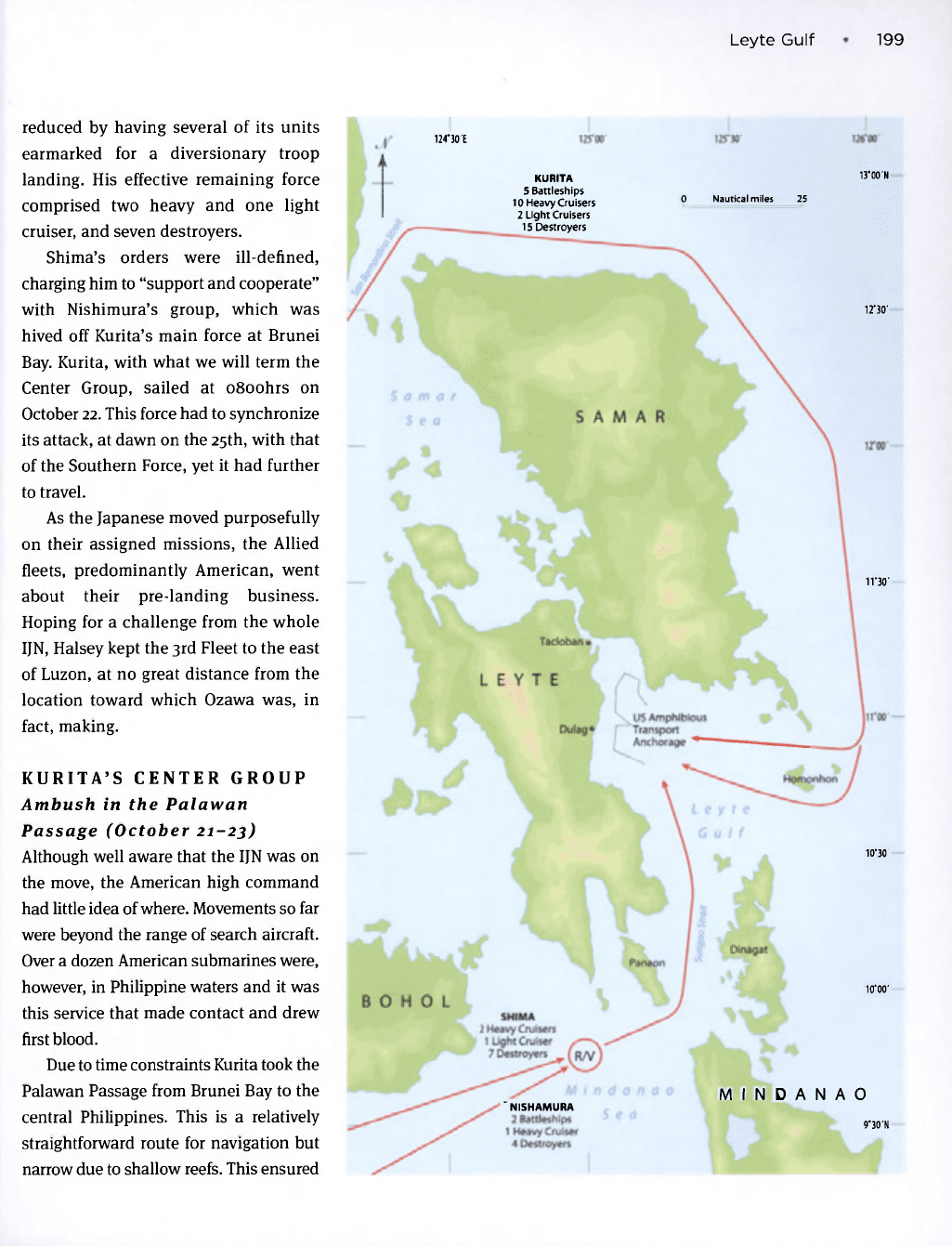
Leyte Gulf • 199
reduced by having several of its units
earmarked for a diversionary troop
landing. His effective remaining force
comprised two heavy and one light
cruiser, and seven destroyers.
Shima's orders were ill-defined,
charging him to "support and cooperate"
with Nishimura's group, which was
hived off Kurita's main force at Brunei
Bay. Kurita, with what we will term the
Center Group, sailed at o8oohrs on
October 22. This force had to synchronize
its attack, at dawn on the 25th, with that
of the Southern Force, yet it had further
to travel.
As the Japanese moved purposefully
on their assigned missions, the Allied
fleets, predominantly American, went
about their pre-landing business.
Hoping for a challenge from the whole
IJN, Halsey kept the 3rd Fleet to the east
of Luzon, at no great distance from the
location toward which Ozawa was, in
fact, making.
KURITA'S CENTER GROUP
Ambush in the Palawan
Passage (October 21-23)
Although well aware that the IJN was on
the move, the American high command
had little idea of where. Movements so far
were beyond the range of search aircraft.
Over a dozen American submarines were,
however, in Philippine waters and it was
this service that made contact and drew
first blood.
Due to time constraints Kurita took the
Palawan Passage from Brunei Bay to the
central Philippines. This is a relatively
straightforward route for navigation but
narrow due to shallow reefs. This ensured
124*30 E
KURITA
5 Battleships
10 Heavy Cruisers
2 Light Cruisers
15 Destroyers
0 Nautical miles 25
13*00 N
12*30'
11*30'
10*30
10*00'
MINDANAO
' NISHAMURA
9'30'N
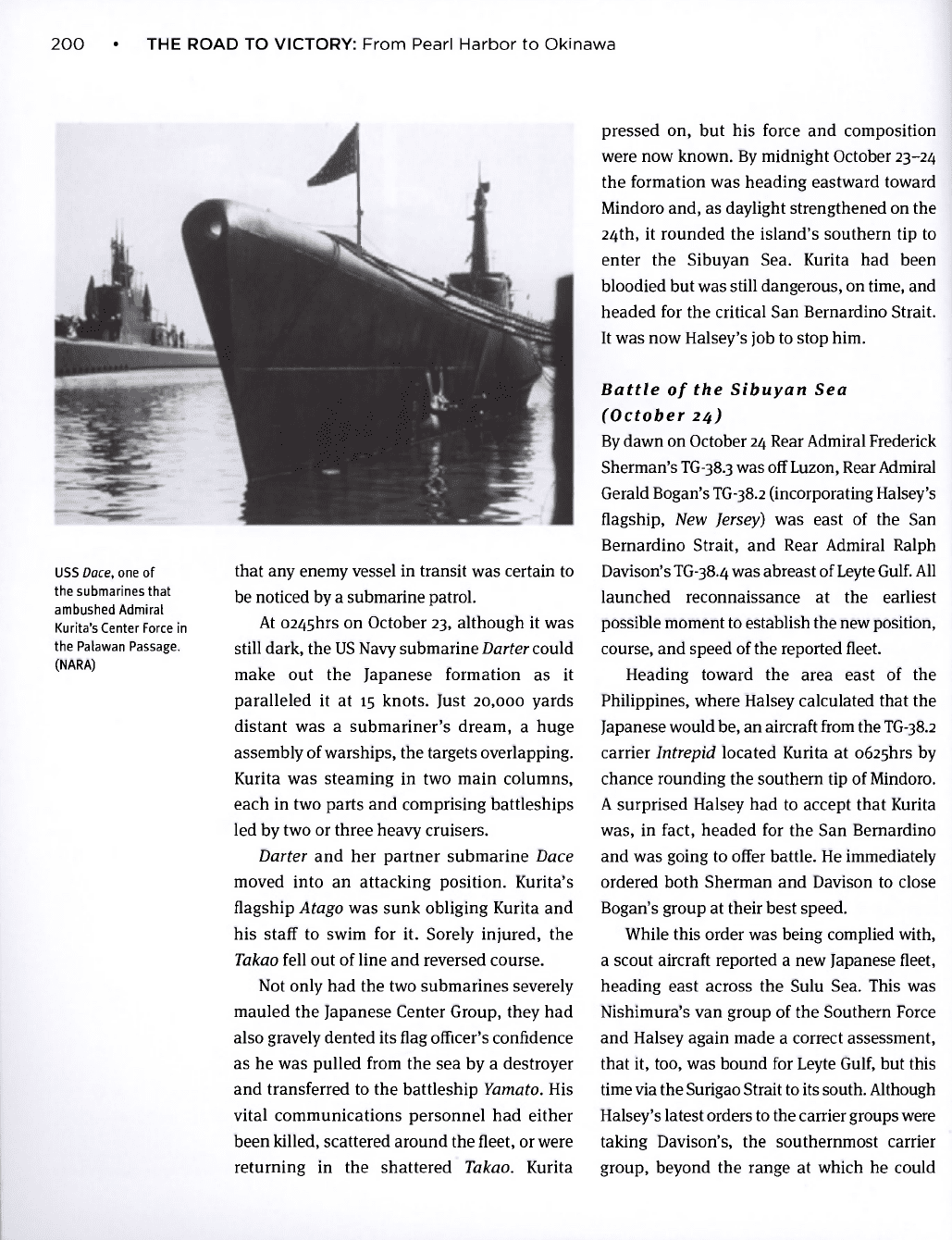
200 • THE ROAD TO VICTORY: From Pearl Harbor to Okinawa
USS Dace, one of
the submarines that
ambushed Admiral
Kurita's Center Force in
the Palawan Passage.
(NARA)
that any enemy vessel in transit was certain to
be noticed by a submarine patrol.
At 0245hrs on October 23, although it was
still dark, the US Navy submarine Darter could
make out the Japanese formation as it
paralleled it at 15 knots. Just 20,000 yards
distant was a submariner's dream, a huge
assembly of warships, the targets overlapping.
Kurita was steaming in two main columns,
each in two parts and comprising battleships
led by two or three heavy cruisers.
Darter and her partner submarine Dace
moved into an attacking position. Kurita's
flagship Atago was sunk obliging Kurita and
his staff to swim for it. Sorely injured, the
Takao fell out of line and reversed course.
Not only had the two submarines severely
mauled the Japanese Center Group, they had
also gravely dented its flag officer's confidence
as he was pulled from the sea by a destroyer
and transferred to the battleship Yamato. His
vital communications personnel had either
been killed, scattered around the fleet, or were
returning in the shattered Takao. Kurita
pressed on, but his force and composition
were now known. By midnight October 23-24
the formation was heading eastward toward
Mindoro and, as daylight strengthened on the
24th, it rounded the island's southern tip to
enter the Sibuyan Sea. Kurita had been
bloodied but was still dangerous, on time, and
headed for the critical San Bernardino Strait.
It was now Halsey's job to stop him.
Battle of the Sibuyan Sea
(October 24)
By dawn on October 24 Rear Admiral Frederick
Sherman's TG-38.3 was off Luzon, Rear Admiral
Gerald Bogan's TG-38.2 (incorporating Halsey's
flagship, New Jersey) was east of the San
Bernardino Strait, and Rear Admiral Ralph
Davison's TG-38.4 was abreast of Leyte Gulf. All
launched reconnaissance at the earliest
possible moment to establish the new position,
course, and speed of the reported fleet.
Heading toward the area east of the
Philippines, where Halsey calculated that the
Japanese would be, an aircraft from the TG-38.2
carrier Intrepid located Kurita at o625hrs by
chance rounding the southern tip of Mindoro.
A surprised Halsey had to accept that Kurita
was, in fact, headed for the San Bernardino
and was going to offer battle. He immediately
ordered both Sherman and Davison to close
Bogan's group at their best speed.
While this order was being complied with,
a scout aircraft reported a new Japanese fleet,
heading east across the Sulu Sea. This was
Nishimura's van group of the Southern Force
and Halsey again made a correct assessment,
that it, too, was bound for Leyte Gulf, but this
time via the Surigao Strait to its south. Although
Halsey's latest orders to the carrier groups were
taking Davison's, the southernmost carrier
group, beyond the range at which he could
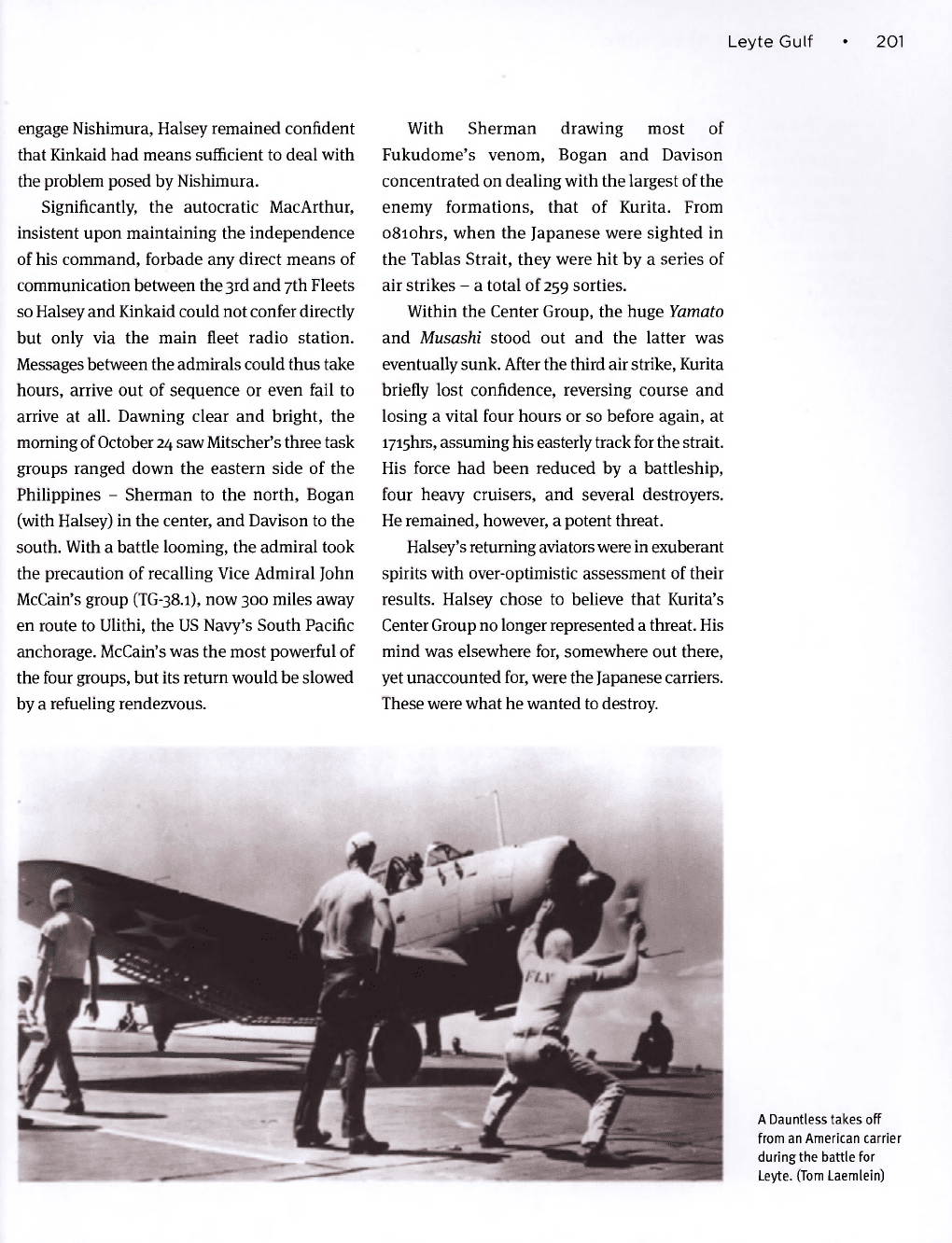
Leyte Gulf • 201
engage Nishimura, Halsey remained confident
that Kinkaid had means sufficient to deal with
the problem posed by Nishimura.
Significantly, the autocratic MacArthur,
insistent upon maintaining the independence
of his command, forbade any direct means of
communication between the 3rd and 7th Fleets
so Halsey and Kinkaid could not confer directly
but only via the main fleet radio station.
Messages between the admirals could thus take
hours, arrive out of sequence or even fail to
arrive at all. Dawning clear and bright, the
morning of October 24 saw Mitscher's three task
groups ranged down the eastern side of the
Philippines - Sherman to the north, Bogan
(with Halsey) in the center, and Davison to the
south. With a battle looming, the admiral took
the precaution of recalling Vice Admiral John
McCain's group (TG-38.1), now 300 miles away
en route to Ulithi, the US Navy's South Pacific
anchorage. McCain's was the most powerful of
the four groups, but its return would be slowed
by a refueling rendezvous.
With Sherman drawing most of
Fukudome's venom, Bogan and Davison
concentrated on dealing with the largest of the
enemy formations, that of Kurita. From
o8iohrs, when the Japanese were sighted in
the Tablas Strait, they were hit by a series of
air strikes - a total of 259 sorties.
Within the Center Group, the huge Yamato
and Musashi stood out and the latter was
eventually sunk. After the third air strike, Kurita
briefly lost confidence, reversing course and
losing a vital four hours or so before again, at
I7i5hrs, assuming his easterly track
for
the strait.
His force had been reduced by a battleship,
four heavy cruisers, and several destroyers.
He remained, however, a potent threat.
Halsey's returning aviators were in exuberant
spirits with over-optimistic assessment of their
results. Halsey chose to believe that Kurita's
Center Group no longer represented a threat. His
mind was elsewhere for, somewhere out there,
yet unaccounted
for,
were the Japanese carriers.
These were what he wanted to destroy.
A Dauntless takes off
from an American carrier
during the battle for
Leyte. (Tom Laemlein)
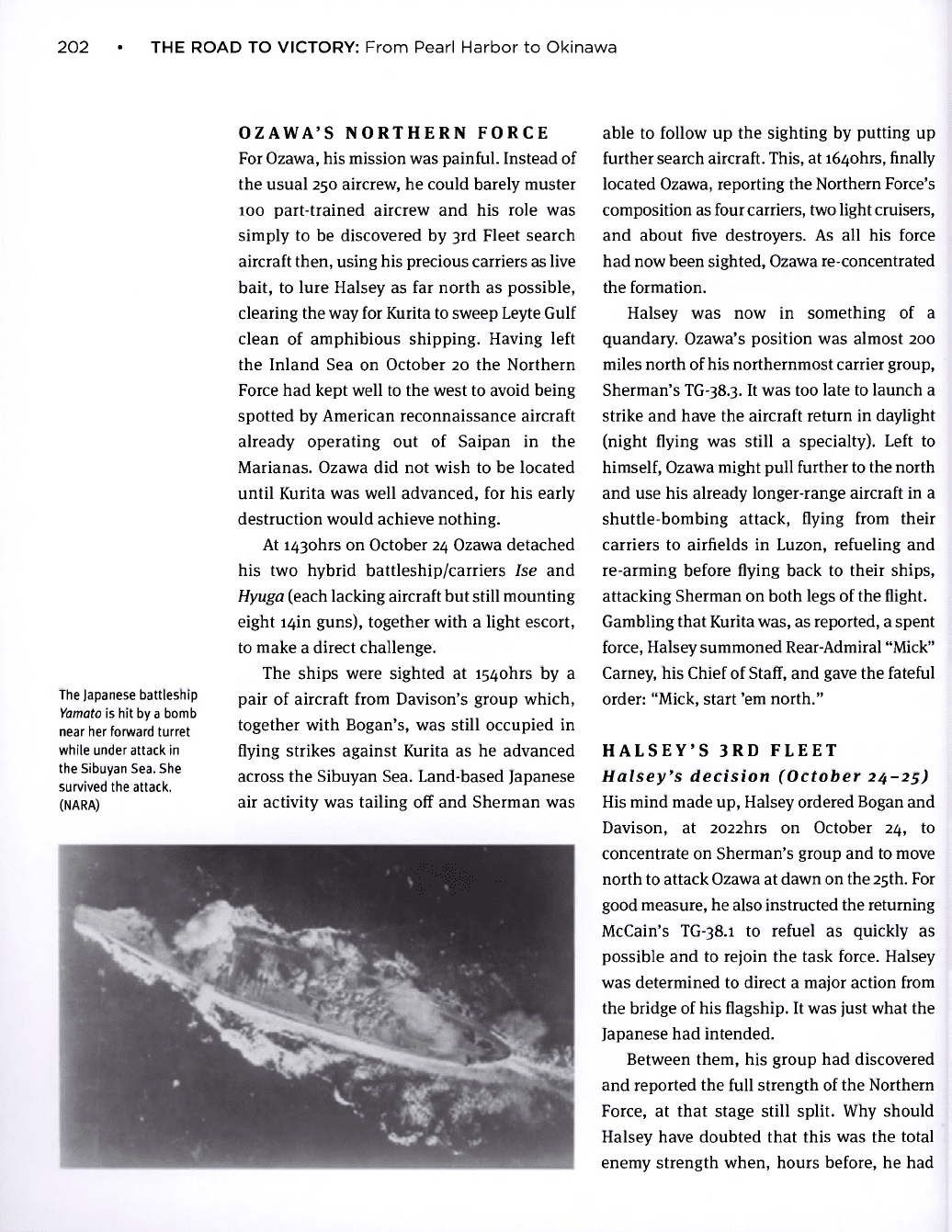
202 • THE ROAD TO VICTORY: From Pearl Harbor to Okinawa
The Japanese battleship
Yamato is hit by a bomb
near her forward turret
while under attack in
the Sibuyan Sea. She
survived the attack.
(NARA)
OZAWA'S NORTHERN FORCE
For Ozawa, his mission was painful. Instead of
the usual 250 aircrew, he could barely muster
100 part-trained aircrew and his role was
simply to be discovered by 3rd Fleet search
aircraft then, using his precious carriers as live
bait, to lure Halsey as far north as possible,
clearing the way for Kurita to sweep Leyte Gulf
clean of amphibious shipping. Having left
the Inland Sea on October 20 the Northern
Force had kept well to the west to avoid being
spotted by American reconnaissance aircraft
already operating out of Saipan in the
Marianas. Ozawa did not wish to be located
until Kurita was well advanced, for his early
destruction would achieve nothing.
At i43ohrs on October 24 Ozawa detached
his two hybrid battleship/carriers Ise and
Hyuga (each lacking aircraft but still mounting
eight i4in guns), together with a light escort,
to make a direct challenge.
The ships were sighted at i54ohrs by a
pair of aircraft from Davison's group which,
together with Bogan's, was still occupied in
flying strikes against Kurita as he advanced
across the Sibuyan Sea. Land-based Japanese
air activity was tailing off and Sherman was
able to follow up the sighting by putting up
further search aircraft. This, at i64ohrs, finally
located Ozawa, reporting the Northern Force's
composition as four carriers, two light cruisers,
and about five destroyers. As all his force
had now been sighted, Ozawa re-concentrated
the formation.
Halsey was now in something of a
quandary. Ozawa's position was almost 200
miles north of his northernmost carrier group,
Sherman's TG-38.3. It was too late to launch a
strike and have the aircraft return in daylight
(night flying was still a specialty). Left to
himself, Ozawa might pull further to the north
and use his already longer-range aircraft in a
shuttle-bombing attack, flying from their
carriers to airfields in Luzon, refueling and
re-arming before flying back to their ships,
attacking Sherman on both legs of the flight.
Gambling that Kurita was, as reported, a spent
force, Halsey summoned Rear-Admiral "Mick"
Carney, his Chief of
Staff,
and gave the fateful
order: "Mick, start 'em north."
HALSEY'S 3RD FLEET
Halsey's decision (October 24-25)
His mind made up, Halsey ordered Bogan and
Davison, at 2022hrs on October 24, to
concentrate on Sherman's group and to move
north to attack Ozawa at dawn on the 25th. For
good measure, he also instructed the returning
McCain's TG-38.1 to refuel as quickly as
possible and to rejoin the task force. Halsey
was determined to direct a major action from
the bridge of his flagship. It was just what the
Japanese had intended.
Between them, his group had discovered
and reported the full strength of the Northern
Force, at that stage still split. Why should
Halsey have doubted that this was the total
enemy strength when, hours before, he had
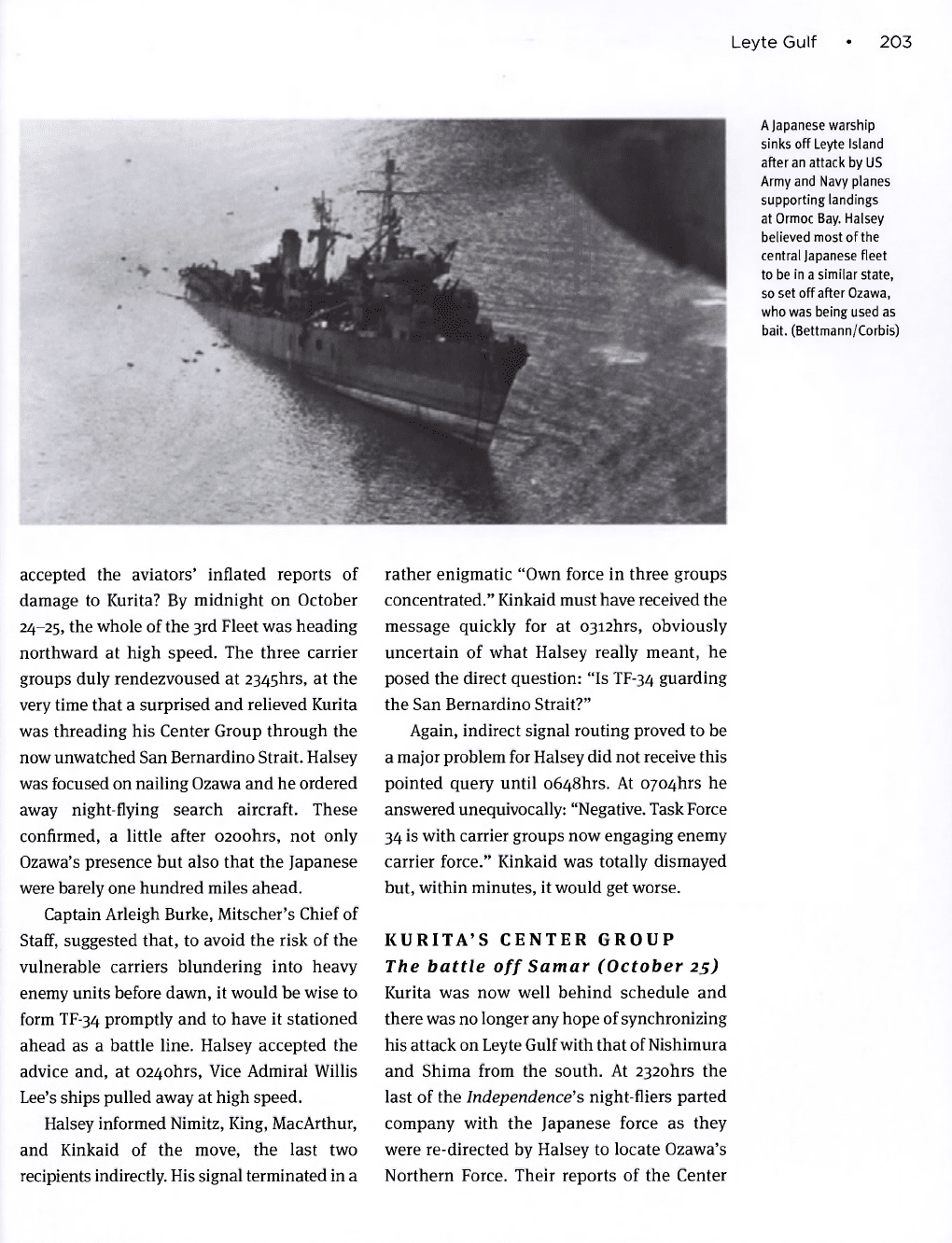
Leyte Gulf • 203
A Japanese warship
sinks off Leyte Island
after an attack by US
Army and Navy planes
supporting landings
at Ormoc Bay. Halsey
believed most of the
central Japanese fleet
to be in a similar state,
so set off after Ozawa,
who was being used as
bait. (Bettmann/Corbis)
accepted the aviators' inflated reports of
damage to Kurita? By midnight on October
24-25, the whole of the 3rd Fleet was heading
northward at high speed. The three carrier
groups duly rendezvoused at 2345hrs, at the
very time that a surprised and relieved Kurita
was threading his Center Group through the
now unwatched San Bernardino Strait. Halsey
was focused on nailing Ozawa and he ordered
away night-flying search aircraft. These
confirmed, a little after 0200hrs, not only
Ozawa's presence but also that the Japanese
were barely one hundred miles ahead.
Captain Arleigh Burke, Mitscher's Chief of
Staff, suggested that, to avoid the risk of the
vulnerable carriers blundering into heavy
enemy units before dawn, it would be wise to
form TF-34 promptly and to have it stationed
ahead as a battle line. Halsey accepted the
advice and, at 0240hrs, Vice Admiral Willis
Lee's ships pulled away at high speed.
Halsey informed Nimitz, King, MacArthur,
and Kinkaid of the move, the last two
recipients indirectly. His signal terminated in a
rather enigmatic "Own force in three groups
concentrated." Kinkaid must have received the
message quickly for at 03i2hrs, obviously
uncertain of what Halsey really meant, he
posed the direct question: "Is TF-34 guarding
the San Bernardino Strait?"
Again, indirect signal routing proved to be
a major problem for Halsey did not receive this
pointed query until o648hrs. At 0704hrs he
answered unequivocally: "Negative. Task Force
34 is with carrier groups now engaging enemy
carrier force." Kinkaid was totally dismayed
but, within minutes, it would get worse.
KURITA'S CENTER GROUP
The battle off Samar (October 25)
Kurita was now well behind schedule and
there was no longer any hope of synchronizing
his attack on Leyte Gulf with that of Nishimura
and Shima from the south. At 232ohrs the
last of the Independence's night-fliers parted
company with the Japanese force as they
were re-directed by Halsey to locate Ozawa's
Northern Force. Their reports of the Center
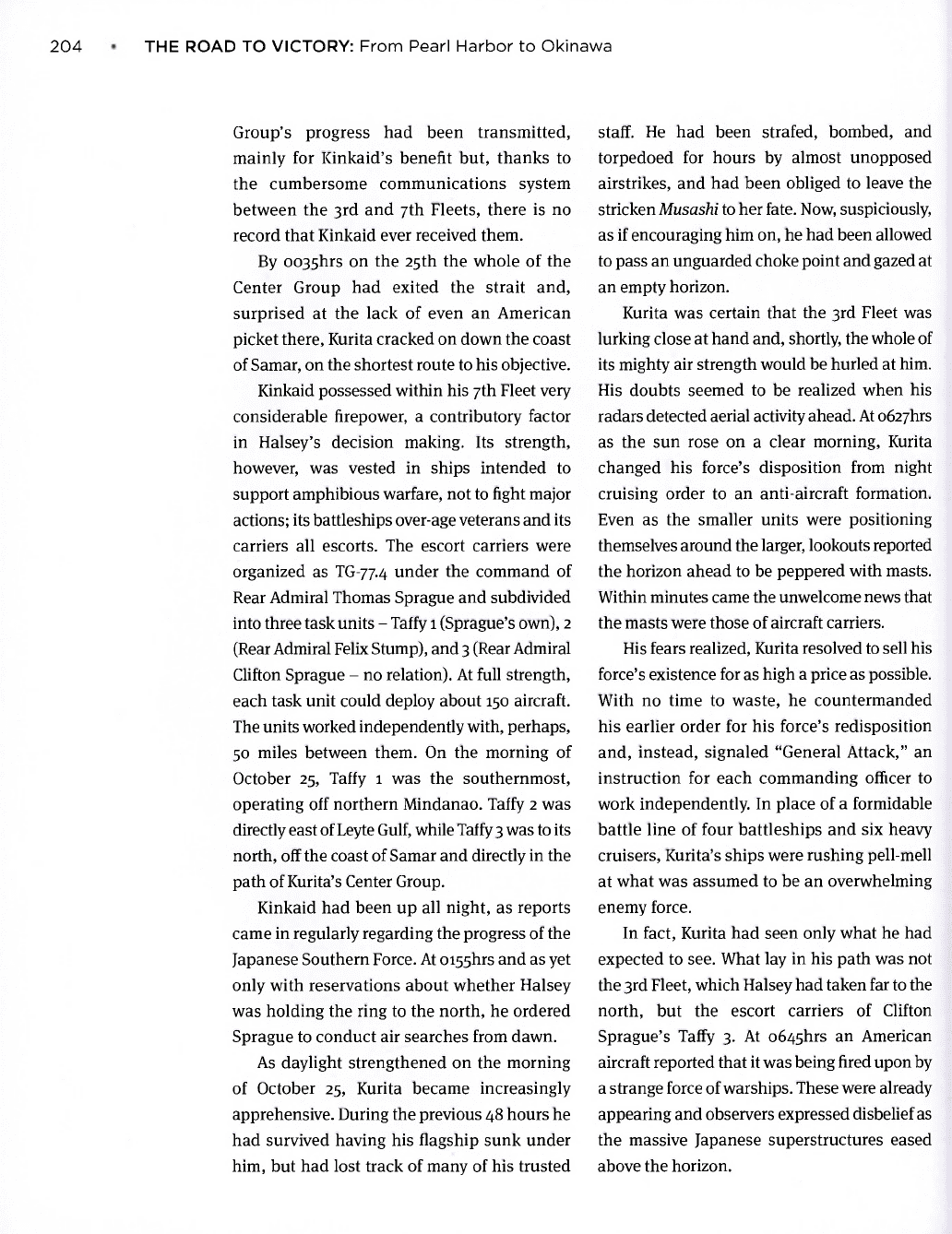
204 • THE ROAD TO VICTORY: From Pearl Harbor to Okinawa
Group's progress had been transmitted,
mainly for Kinkaid's benefit but, thanks to
the cumbersome communications system
between the 3rd and 7th Fleets, there is no
record that Kinkaid ever received them.
By 0035hrs on the 25th the whole of the
Center Group had exited the strait and,
surprised at the lack of even an American
picket there, Kurita cracked on down the coast
of Samar, on the shortest route to his objective.
Kinkaid possessed within his 7th Fleet very
considerable firepower, a contributory factor
in Halsey's decision making. Its strength,
however, was vested in ships intended to
support amphibious warfare, not to fight major
actions; its battleships over-age veterans and its
carriers all escorts. The escort carriers were
organized as TG-77.4 under the command of
Rear Admiral Thomas Sprague and subdivided
into three task units -
Taffy
1 (Sprague's own), 2
(Rear Admiral Felix Stump), and 3 (Rear Admiral
Clifton Sprague - no relation). At full strength,
each task unit could deploy about 150 aircraft.
The units worked independently with, perhaps,
50 miles between them. On the morning of
October 25, Taffy 1 was the southernmost,
operating off northern Mindanao. Taffy 2 was
directly east of Leyte Gulf, while
Taffy
3 was to its
north, off the coast of Samar and directly in the
path of Kurita's Center Group.
Kinkaid had been up all night, as reports
came in regularly regarding the progress of the
Japanese Southern Force. At oisshrs and as yet
only with reservations about whether Halsey
was holding the ring to the north, he ordered
Sprague to conduct air searches from dawn.
As daylight strengthened on the morning
of October 25, Kurita became increasingly
apprehensive. During the previous 48 hours he
had survived having his flagship sunk under
him, but had lost track of many of his trusted
staff. He had been strafed, bombed, and
torpedoed for hours by almost unopposed
airstrikes, and had been obliged to leave the
stricken Musashi to her fate. Now, suspiciously,
as if encouraging him on, he had been allowed
to pass an unguarded choke point and gazed at
an empty horizon.
Kurita was certain that the 3rd Fleet was
lurking close at hand and, shortly, the whole of
its mighty air strength would be hurled at him.
His doubts seemed to be realized when his
radars detected aerial activity ahead. At o627hrs
as the sun rose on a clear morning, Kurita
changed his force's disposition from night
cruising order to an anti-aircraft formation.
Even as the smaller units were positioning
themselves around the larger, lookouts reported
the horizon ahead to be peppered with masts.
Within minutes came the unwelcome news that
the masts were those of aircraft carriers.
His fears realized, Kurita resolved to sell his
force's existence for as high a price as possible.
With no time to waste, he countermanded
his earlier order for his force's redisposition
and, instead, signaled "General Attack," an
instruction for each commanding officer to
work independently. In place of a formidable
battle line of four battleships and six heavy
cruisers, Kurita's ships were rushing pell-mell
at what was assumed to be an overwhelming
enemy force.
In fact, Kurita had seen only what he had
expected to see. What lay in his path was not
the 3rd Fleet, which Halsey had taken far to the
north, but the escort carriers of Clifton
Sprague's Taffy 3. At o645hrs an American
aircraft reported that it was being fired upon by
a strange force of warships. These were already
appearing and observers expressed disbelief as
the massive Japanese superstructures eased
above the horizon.
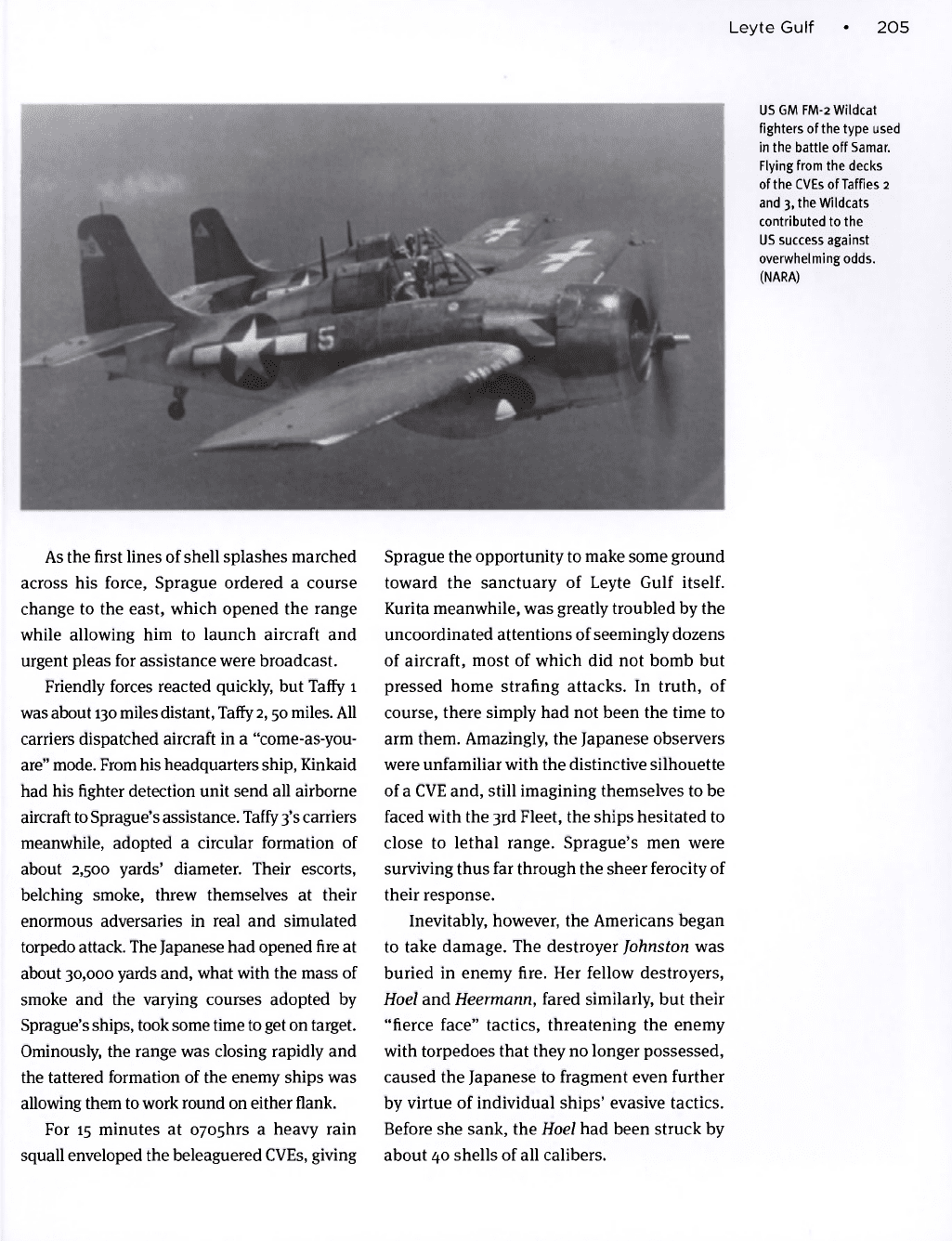
Leyte Gulf • 205
US GM FM-2 Wildcat
fighters of the type used
in the battle off Samar.
Flying from the decks
of the CVEs of Taffies 2
and 3, the Wildcats
contributed to the
US success against
overwhelming odds.
(NARA)
As the first lines of shell splashes marched
across his force, Sprague ordered a course
change to the east, which opened the range
while allowing him to launch aircraft and
urgent pleas for assistance were broadcast.
Friendly forces reacted quickly, but Taffy l
was about 130 miles distant,
Taffy
2,50 miles. All
carriers dispatched aircraft in a "come-as-you-
are" mode. From his headquarters ship, Kinkaid
had his fighter detection unit send all airborne
aircraft to Sprague's assistance.
Taffy
3's carriers
meanwhile, adopted a circular formation of
about 2,500 yards' diameter. Their escorts,
belching smoke, threw themselves at their
enormous adversaries in real and simulated
torpedo attack. The Japanese had opened fire at
about 30,000 yards and, what with the mass of
smoke and the varying courses adopted by
Sprague's ships, took some time to get on target.
Ominously, the range was closing rapidly and
the tattered formation of the enemy ships was
allowing them to work round on either flank.
For 15 minutes at ozoshrs a heavy rain
squall enveloped the beleaguered CVEs, giving
Sprague the opportunity to make some ground
toward the sanctuary of Leyte Gulf itself.
Kurita meanwhile, was greatly troubled by the
uncoordinated attentions of seemingly dozens
of aircraft, most of which did not bomb but
pressed home strafing attacks. In truth, of
course, there simply had not been the time to
arm them. Amazingly, the Japanese observers
were unfamiliar with the distinctive silhouette
of a CVE and, still imagining themselves to be
faced with the 3rd Fleet, the ships hesitated to
close to lethal range. Sprague's men were
surviving thus far through the sheer ferocity of
their response.
Inevitably, however, the Americans began
to take damage. The destroyer Johnston was
buried in enemy fire. Her fellow destroyers,
Hoel and Heermann, fared similarly, but their
"fierce face" tactics, threatening the enemy
with torpedoes that they no longer possessed,
caused the Japanese to fragment even further
by virtue of individual ships' evasive tactics.
Before she sank, the Hoel had been struck by
about 40 shells of all calibers.
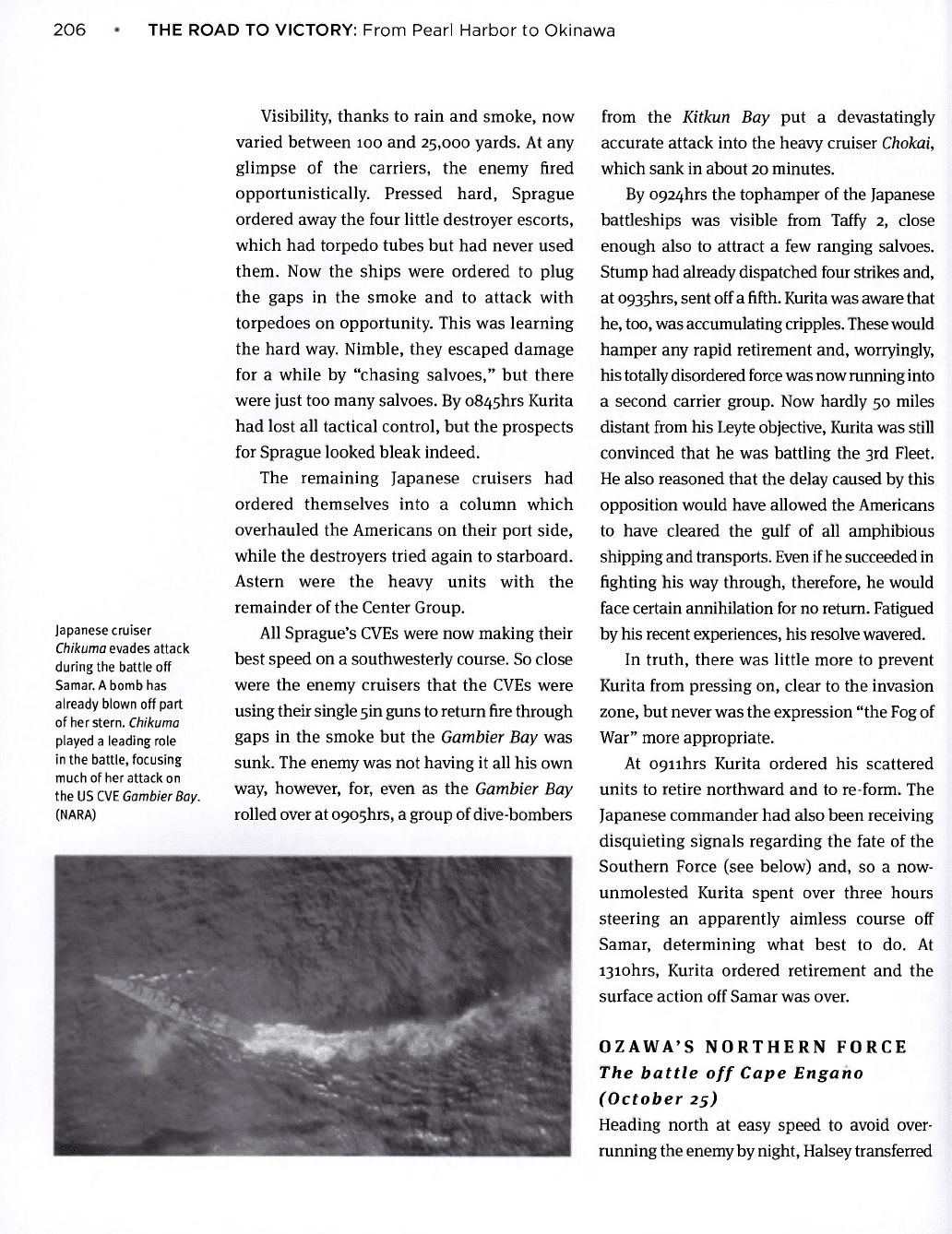
206 • THE ROAD TO VICTORY: From Pearl Harbor to Okinawa
Visibility, thanks to rain and smoke, now
varied between 100 and 25,000 yards. At any
glimpse of the carriers, the enemy fired
opportunistically. Pressed hard, Sprague
ordered away the four little destroyer escorts,
which had torpedo tubes but had never used
them. Now the ships were ordered to plug
the gaps in the smoke and to attack with
torpedoes on opportunity. This was learning
the hard way. Nimble, they escaped damage
for a while by "chasing salvoes," but there
were just too many salvoes. By o845hrs Kurita
had lost all tactical control, but the prospects
for Sprague looked bleak indeed.
The remaining Japanese cruisers had
ordered themselves into a column which
overhauled the Americans on their port side,
while the destroyers tried again to starboard.
Astern were the heavy units with the
remainder of the Center Group.
All Sprague's CVEs were now making their
best speed on a southwesterly course. So close
were the enemy cruisers that the CVEs were
using their single sin guns to return fire through
gaps in the smoke but the Gambier Bay was
sunk. The enemy was not having it all his own
way, however, for, even as the Gambier Bay
rolled over at 0905hrs, a group of dive-bombers
Japanese cruiser
Chikuma evades attack
during the battle off
Samar. A bomb has
already blown off part
of her stern. Chikuma
played a leading role
in the battle, focusing
much of her attack on
theUSCVE Gambier Bay.
(NARA)
from the Kitkun Bay put a devastatingly
accurate attack into the heavy cruiser Chokai,
which sank in about 20 minutes.
By 0924hrs the tophamper of the Japanese
battleships was visible from Taffy 2, close
enough also to attract a few ranging salvoes.
Stump had already dispatched four strikes and,
at 0935hrs, sent off a fifth. Kurita was aware that
he, too, was accumulating cripples. These would
hamper any rapid retirement and, worryingly,
his totally disordered force was now running into
a second carrier group. Now hardly 50 miles
distant from his Leyte objective, Kurita was still
convinced that he was battling the 3rd Fleet.
He also reasoned that the delay caused by this
opposition would have allowed the Americans
to have cleared the gulf of all amphibious
shipping and transports. Even if he succeeded in
fighting his way through, therefore, he would
face certain annihilation for no return. Fatigued
by his recent experiences, his resolve wavered.
In truth, there was little more to prevent
Kurita from pressing on, clear to the invasion
zone, but never was the expression "the Fog of
War" more appropriate.
At 09iihrs Kurita ordered his scattered
units to retire northward and to re-form. The
Japanese commander had also been receiving
disquieting signals regarding the fate of the
Southern Force (see below) and, so a now-
unmolested Kurita spent over three hours
steering an apparently aimless course off
Samar, determining what best to do. At
i3iohrs, Kurita ordered retirement and the
surface action off Samar was over.
OZAWA'S NORTHERN FORCE
The battle off Cape Engano
(October 25)
Heading north at easy speed to avoid over-
running the enemy by night, Halsey transferred
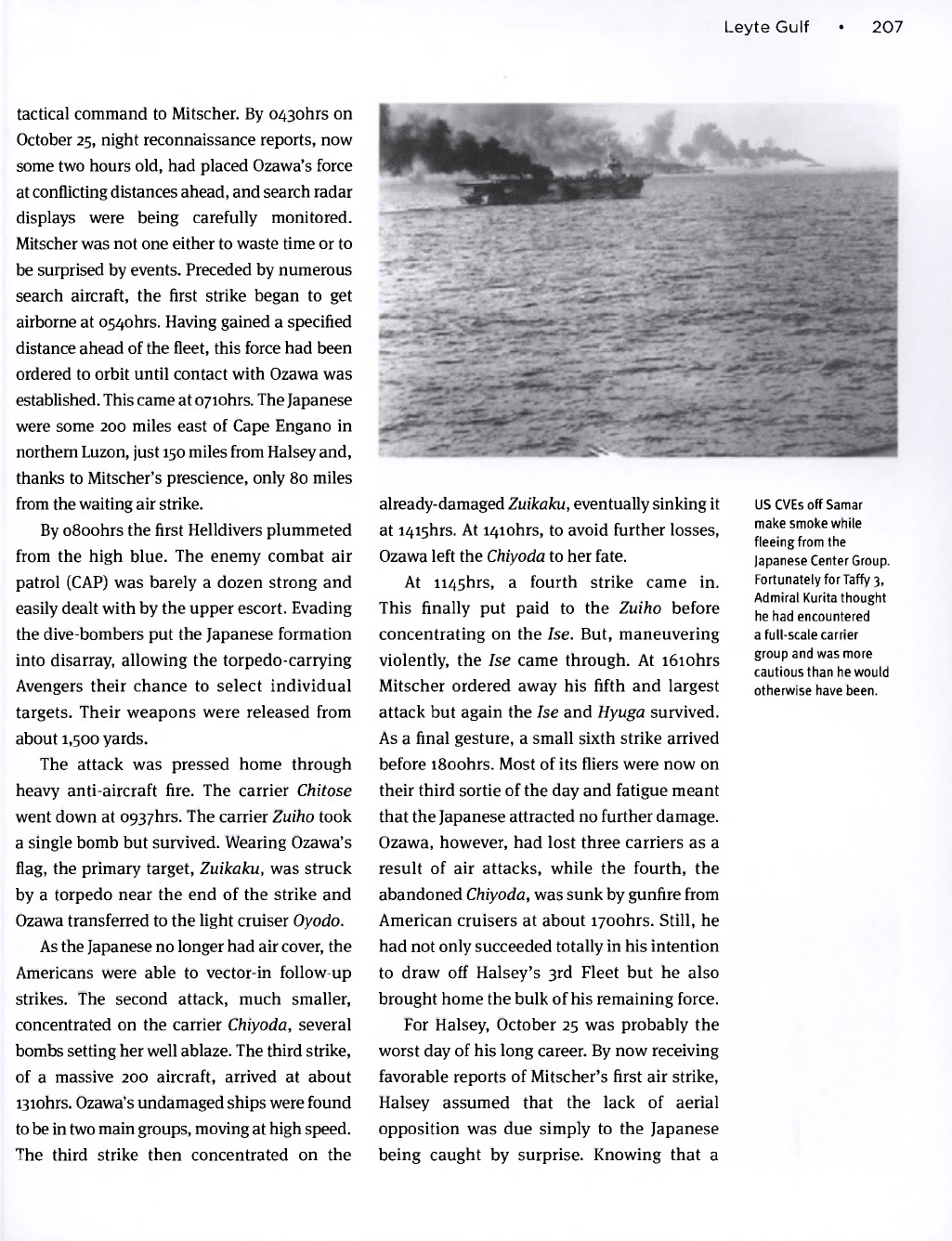
Leyte Gulf • 207
tactical command to Mitscher. By 0430hrs on
October 25, night reconnaissance reports, now
some two hours old, had placed Ozawa's force
at conflicting distances ahead, and search radar
displays were being carefully monitored.
Mitscher was not one either to waste time or to
be surprised by events. Preceded by numerous
search aircraft, the first strike began to get
airborne at os^ohrs. Having gained a specified
distance ahead of the fleet, this force had been
ordered to orbit until contact with Ozawa was
established. This came at oyiohrs. The Japanese
were some 200 miles east of Cape Engano in
northern Luzon, just 150 miles from Halsey and,
thanks to Mitscher's prescience, only 80 miles
from the waiting air strike.
By o8oohrs the first Helldivers plummeted
from the high blue. The enemy combat air
patrol (CAP) was barely a dozen strong and
easily dealt with by the upper escort. Evading
the dive-bombers put the Japanese formation
into disarray, allowing the torpedo-carrying
Avengers their chance to select individual
targets. Their weapons were released from
about 1,500 yards.
The attack was pressed home through
heavy anti-aircraft fire. The carrier Chitose
went down at 0937hrs. The carrier Zuiho took
a single bomb but survived. Wearing Ozawa's
flag, the primary target, Zuikaku, was struck
by a torpedo near the end of the strike and
Ozawa transferred to the light cruiser Oyodo.
As the Japanese no longer had air cover, the
Americans were able to vector-in follow-up
strikes. The second attack, much smaller,
concentrated on the carrier Chiyoda, several
bombs setting her well ablaze. The third strike,
of a massive 200 aircraft, arrived at about
i3iohrs. Ozawa's undamaged ships were found
to be in two main groups, moving at high speed.
The third strike then concentrated on the
already-damaged Zuikaku, eventually sinking it
at I4i5hrs. At l^iohrs, to avoid further losses,
Ozawa left the Chiyoda to her fate.
At ii45hrs, a fourth strike came in.
This finally put paid to the Zuiho before
concentrating on the Ise. But, maneuvering
violently, the Ise came through. At i6iohrs
Mitscher ordered away his fifth and largest
attack but again the Ise and Hyuga survived.
As a final gesture, a small sixth strike arrived
before i8oohrs. Most of its fliers were now on
their third sortie of the day and fatigue meant
that the Japanese attracted no further damage.
Ozawa, however, had lost three carriers as a
result of air attacks, while the fourth, the
abandoned Chiyoda, was sunk by gunfire from
American cruisers at about lzoohrs. Still, he
had not only succeeded totally in his intention
to draw off Halsey's 3rd Fleet but he also
brought home the bulk of his remaining force.
For Halsey, October 25 was probably the
worst day of his long career. By now receiving
favorable reports of Mitscher's first air strike,
Halsey assumed that the lack of aerial
opposition was due simply to the Japanese
being caught by surprise. Knowing that a
US CVEs off Samar
make smoke while
fleeing from the
Japanese Center Group.
Fortunately for Taffy 3,
Admiral Kurita thought
he had encountered
a full-scale carrier
group and was more
cautious than he would
otherwise have been.
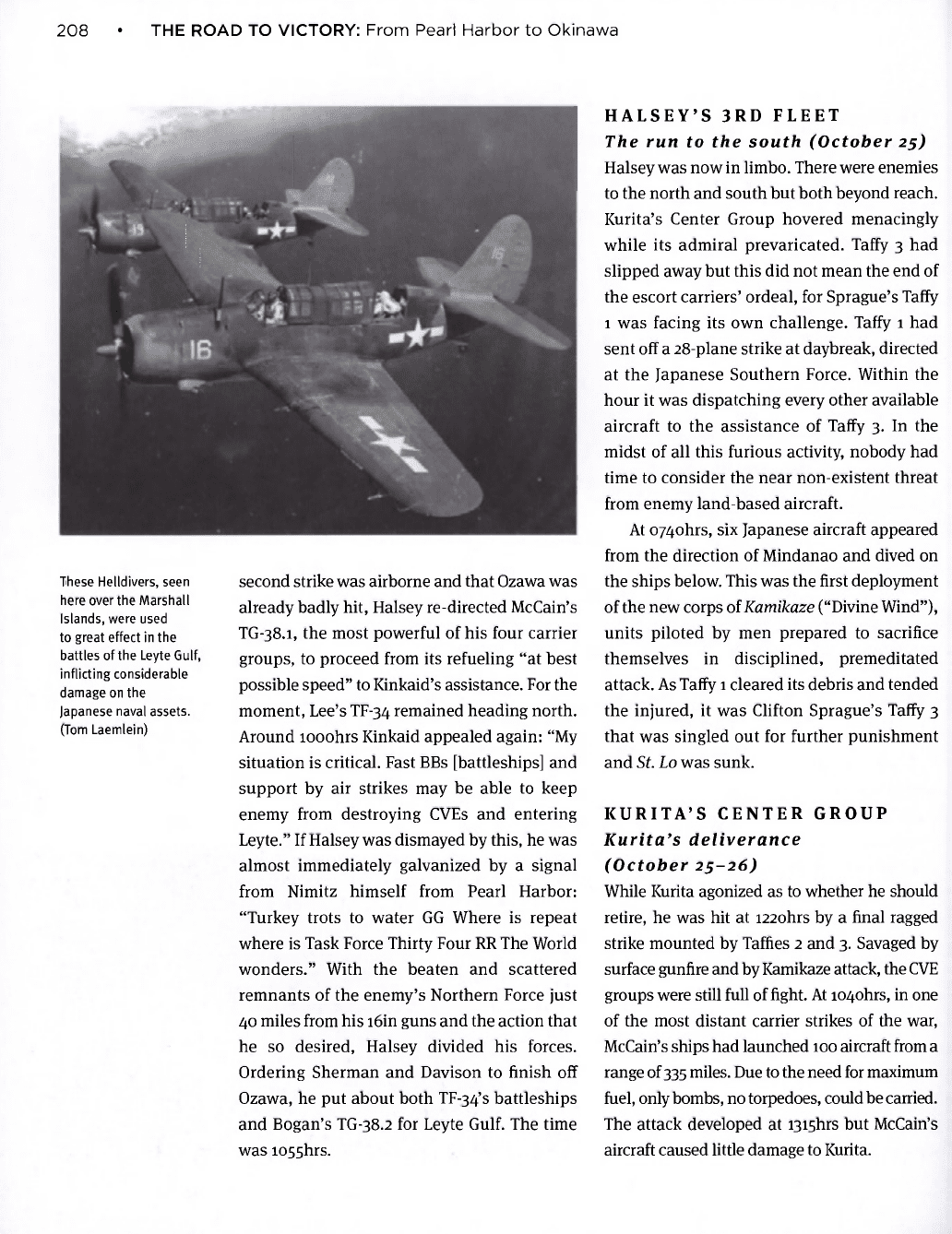
208 • THE ROAD TO VICTORY: From Pearl Harbor to Okinawa
These Helldivers, seen
here over the Marshall
Islands, were used
to great effect in the
battles of the Leyte Gulf,
inflicting considerable
damage on the
Japanese naval assets.
(Tom Laemlein)
second strike was airborne and that Ozawa was
already badly hit, Halsey re-directed McCain's
TG-38.1, the most powerful of his four carrier
groups, to proceed from its refueling "at best
possible speed" to Kinkaid's assistance. For the
moment, Lee's TF-34 remained heading north.
Around looohrs Kinkaid appealed again: "My
situation is critical. Fast BBs [battleships] and
support by air strikes may be able to keep
enemy from destroying CVEs and entering
Leyte." If Halsey was dismayed by this, he was
almost immediately galvanized by a signal
from Nimitz himself from Pearl Harbor:
"Turkey trots to water GG Where is repeat
where is Task Force Thirty Four RR The World
wonders." With the beaten and scattered
remnants of the enemy's Northern Force just
40 miles from his i6in guns and the action that
he so desired, Halsey divided his forces.
Ordering Sherman and Davison to finish off
Ozawa, he put about both TF-34's battleships
and Bogan's TG-38.2 for Leyte Gulf. The time
was losshrs.
HALSEY'S 3RD FLEET
The run to the south (October 25)
Halsey was now in limbo. There were enemies
to the north and south but both beyond reach.
Kurita's Center Group hovered menacingly
while its admiral prevaricated. Taffy 3 had
slipped away but this did not mean the end of
the escort carriers' ordeal, for Sprague's Taffy
1 was facing its own challenge. Taffy 1 had
sent off a 28-plane strike at daybreak, directed
at the Japanese Southern Force. Within the
hour it was dispatching every other available
aircraft to the assistance of Taffy 3. In the
midst of all this furious activity, nobody had
time to consider the near non-existent threat
from enemy land-based aircraft.
At 0740hrs, six Japanese aircraft appeared
from the direction of Mindanao and dived on
the ships below. This was the first deployment
of the new corps of Kamikaze ("Divine Wind"),
units piloted by men prepared to sacrifice
themselves in disciplined, premeditated
attack. As Taffy 1 cleared its debris and tended
the injured, it was Clifton Sprague's Taffy 3
that was singled out for further punishment
and St. Lo was sunk.
KURITA'S CENTER GROUP
Kurita's deliverance
(October 25-26)
While Kurita agonized as to whether he should
retire, he was hit at i22ohrs by a final ragged
strike mounted by Taffies 2 and 3. Savaged by
surface gunfire and by Kamikaze attack, the CVE
groups were still full of fight. At io4ohrs, in one
of the most distant carrier strikes of the war,
McCain's ships had launched 100 aircraft from a
range of 335 miles. Due to the need for maximum
fuel, only bombs, no torpedoes, could be carried.
The attack developed at i3ishrs but McCain's
aircraft caused little damage to Kurita.
